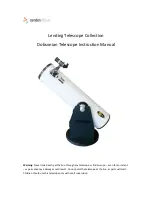
Appendix E - Operational Tips
106
APPENDIX E - OPERATION TIPS
Setting the backlash compensations for an auto guider
HAND CONTROL RESPONSE
The Ultima 2000 has a unique user programmable anti-backlash feature. Due to the enormous gear
reductions required for Alt-Az tracking and also the fact that direction changes are required, a high speed
crossover and dead zone centering feature is supplied. Depending upon the amount of backlash
compensation desired, an interval of time is required for this to properly occur after a directional button is
pressed and released. Upon releasing a button, the tracking motor centers itself, in the dead zone, to offer a
shortened response time to the next button movement command. A couple of seconds is usually required
for this re-centering. A relaxed (under damped) button response gives best results while guiding (it is best
to wait a second or two before pressing a button again). This is true for both human and auto-guiders. For
equatorially mounted telescopes, the RA tracking will not require or use the backlash compensation (this is
true for photo rate and 2X sidereal) since button corrections never reverse the RA tracking motor. The 6X
centering speed uses the backlash compensation since it can reverse during visual acquisition of objects.
The declination axis nearly always reverses direction whether in equatorial or Alt-Az , so backlash
compensation is important there.
AUTO GUIDING
As explained above, the Ultima 2000 requires under damped, relaxed commands to guide with backlash
compensation activated. If your auto guider can be adjusted to make corrections about every 5 seconds, this
should allow for best results.
Viewing near the zenith in Alt-Az
Altazimuth tracking requires motors on both axis to move at varying rates. The rates are dependent on
which part of the sky the telescope is pointed and the latitude of your observing location. If you are
observing stars rising in the east, the altitude tracking motor is doing almost all the work. If you are
observing near the celestial equator and close to the meridian, then the azimuth motor is doing nearly all the
work. Altazimuth tracking becomes extremely difficult at and near the zenith. As the telescope tracks close
to the zenith, the azimuth tracking motors must run very fast. As the telescope tracks across the zenith, the
azimuth tracking motors need to run infinitely fast. Since this is not possible, the telescope will not track
well near the zenith. You will also notice that the azimuth centering speed seems very slow as you get
closer to the zenith. This is a normal effect of observing near the zenith with an altazimuth mount. You
will not notice these problems if you are using a wedge and polar align the telescope.
The effects of a star diagonal on pointing accuracy
A diagonal can slightly change the optical axis of a telescope. A star that is in the center of the field in an
eyepiece can be off center when a diagonal is used. This angular error is known as cone angle. If you
center the star in the eyepiece then rotate the diagonal, you will notice the star does not stay in one place.
This is because the diagonal mirror is not placed perfectly in its holder (all diagonals are like this except for
collimated diagonals). Because of this you need to be aware of how to use a diagonal with a computerized
telescope. Let’s consider altitude first.









































